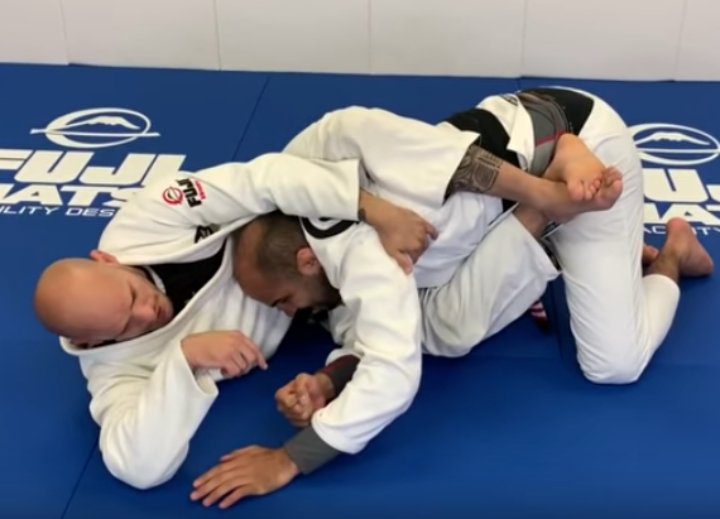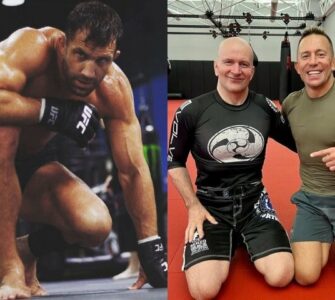When I started BJJ in 1994 the Closed Guard was not just a position. It was the magic pill that makes you invincible. Royce Gracie was fighting in the UFC choking people out and breaking arms from the closed guard and it seemed that being on your back with your legs wrapped around your opponent was a pretty good place to be.
I remember that even when I was purple belt in 2004 the closed guard was my favorite guard position and I used it all the time with triangles, armbars and sweeps. However in the following years the closed guard was used less and less and even in my own training I was facing more and more problems using this old position.
In this article I would like explain why the closed guard isn´t used much anymore and I will show a few principles that can help you to make your closed guard great again.:-) So before we talk about solutions, let´s talk about the problems first.
Closed Guard problems
Rolling from the knees or not using takedowns much
I never trained much in the Gi since my focus was always on MMA and Submission Wrestling training and usually in my earlier years we started our rolling sessions from standing. When you go for leg takedowns like the double-leg takedown you will pretty often end up in the closed guard of your opponent and if your opponent is initiating the takedown he will end up in your guard.
Later when we start rolling from our knees or when people in Submission Wrestling did not fight for the takedown anymore but were pulling guard or just sitting down the closed guard was not happening so easy anymore.
If you start sitting or at least one guy sitting and the other standing there is a lot of distance and time that prevent the closed guard. If the guy on bottom wants to wrap the legs around his opponent it is a long way and no skilled opponent will allow him to close the guard. Instead he will take the chance and try to pass the legs.
So when you start rolling from your knees it is highly unlikely today that you will just be able to pull closed guard. You have to make little steps from quarter guard to half guard and then maybe to closed guard. This is a pretty long way and people are starting to work more and more from quarter and half guard or initiating leglocks then going for the closed guard. This isn´t a bad thing it just takes away the focus from the closed guard and that is what we are seeing today.
Leglocks
If you are in the closed guard on the bottom with your legs wrapped around his body essentially you give him the chance of attacking both of your legs with leglocks. Especially if you don´t train with the Gi and not use the IBJJF rules leglocks are something you have to acknowledge and you have to deal with them frequently. If leglocks and reaping is allowed you can´t play a lazy type of closed guard opening and closing legs frequently and trying to flow from attack to attack. If you do so you will easily end up in a leglock. Armbars, triangle chokes and sweeps can be easily countered with leglocks and the lack of control in Submission Wrestling is an additional problem.
For me dealing with leglocks was the biggest gamechanger in the development of my new closed guard because leglocks make you work much tighter and more aggressive from your back. I will explain late more about that when it comes to the principles of a successful closed guard.
No-Gi Training
If you training without the Gi a lot of the classical techniques will not work or at least will not work frequently against skilled opponents. You do not have lapel chokes you can not grab the sleeves and there is less friction when you apply armbars or triangle chokes. I would say in No-Gi your arms do less and your legs have to do more to compensate the missing grips on your opponents gi.
If you are missing good leg work and lower body dexterity you will likely quit playing closed guard and focus more on other guards or positions.
Punches
If you want to defend yourself against strikes being in closed guard you need also pretty good leg control. If you are trying to pull your opponent close to you by just using your arms it will be pretty difficult to be successful against a stronger opponent. Even classical no-gi control techniques like the overhook and underhook only work well with strong leg control and pressure from the bottom.
From my own experience I would say that my blue and purple belt closed guard 15 years ago was pretty lazy. I was closing my legs and then playing with a lot of sweeps and attacks without being overly aggressive. Closed Guard for me was a place to chill out and sooner or later get submission anyway. It was exactly this attitude which “killed” my closed guard and let me rethink the whole concept of this position.
Today I have a very different approach which I will explain you know. I do not see the closed guard as a control position anymore but as the beginning of an attacking combo. There is constant pressure from the bottom and from the minute I enter this position I am thinking about very few but effective sweeps and submissions I can use from there.
Closed guard principles
Principle 1 – Pressure
This is one of the most important principles from the closed guard and it is often misunderstood. Pressure does not mean to pull your opponent down with your legs but to attach your bodyweight at his body so your own bodyweight is constantly dragging him forward and allows you to break his posture.
If you are able to connect your upper and lower body together like I show in the first video you are able to use your own bodyweight to pull your opponent down and that creates more power than if you would just pull him forward with your hip flexor muscles.
If you are able to put pressure from the bottom against your opponent you can use the rest of your body to attack and as soon as you break his posture your bodyweight will automatically pull him forward and down.
You do not open your legs but create a strong attachment so your opponent has to carry your weight while you don´t waste much strength and energy. Pressure is the underlying concept that has to be always present as soon as you wrap your legs around your opponent.
Principle 2 – If you want to break his posture, break his structure and keep your pressure
Breaking someones posture from bottom of the closed guard could sometimes be really difficult. If you pull to much with your arms and forget your legs and the pressure you can create with them you will have problems if you have a strong opponent. Especially without the Gi you don´t have the grips to apply your strength and even if you can apply it your arm strength is pretty limited against someone who is using his whole body to stay upright.
When it comes to posture breaking I suggest small steps. Manipulate the wrists, do your hand fighting. Try to rotate his forearms out, get a 2 on 1, etc. Don´t pull his head down but take away your opponents arms to weakening his base. When you stay connected your bodyweight will pull him immediately forward as soon as his structure is broken. Don´t break his posture by pulling him down with your arms. Break the structure of his arms and his body and then let your bodyweight do the rest. Small steps will work much better than big pulling movements with your arm. You can see it in the second video.
The most important thing is to use your pressure when your opponents posture is broken, Keep hin down with your bodyweight so your arms are not too much occupied with holding him down and you can use them to start your attacks.
Principle 3- Constantly attack your opponent
That is a very important concept. Don´t see the closed guard as a control position but as the beginning of your back take, sweep or submission. You do not enter the closed guard to wait and chill but to attack immediately. Like I said before if you put your opponent between your legs you give him two opportunities for leglocks and that is exactly the reason why you have to attack. There is no safe way out of the guard if you are not attacking. You need to sweep or take his back to get in a better position and continue your progression in the positional hierarchy. If you just hang out in closed guard or you do some guard retention with open legs you will either get passed or more likely end up in a leglock. This mindet leads us to principle 4 which is all about attacks.
Principle 4 – Do not open your legs and chose the right attacks.
In my blue and purple belt days I had a pretty relaxed guard game. I played a lot with triangles, armbars and the Oma Plata and therefore my legs where open and I did a lot of legwork. Against a good leglocker you can´t play that game anymore because every triangle or armbar attempt puts you in the risk of getting leglocked. My closed guard approach today is very different. First of all: I do not open my legs easily and I use attacks that don´t require to much work with open legs.
Basically my first attack is a sweep or the back take. After securing a 2 on 1 or an armdrag I put his arm across his chest and work my way up to the side. You can see it in the second video. If I can sweep my opponent I can land in a strong mount position and if I decide to take the back it will give me also a very good position. You can see my back take in the third video. In both cases I do not have to open my legs much and have good control over my opponent. Usually my primary attacks from the closed guard are:
2 on 1 to Sweep
2 on 1 to Back Take
Basic Flower Sweep
I throw in some occasionally triangle chokes and Oma Platas but I usually I keep it pretty tight and do not open my legs much. For me closed guard is a very aggressive position and with my primary attacks I can keep the pressure up the whole time so my opponent has do deal with my bodyweight which makes him more vulnerable when I attack his posture.
When you use these four principles while playing closed guard you will recognize that this position will feel very different for you. There is a tight connection between you and your opponent and you will actually feel how your bodyweight is off balancing him. You don´t have to squeeze your legs together like crazy which just gives you sore adductors and hip flexors you just need to connect your lower and upper body and let the weight pull down your opponent. Over time you will love the aggressive nature of the closed guard and as soon as you wrap your legs around someone he is fighting for his balance.
First Video – Pressure:
Second video- Arm Drag & Posture Breaking
Third video – Back Take
Björn Friedrich
www.EffortlessJiuJitsu.com


















